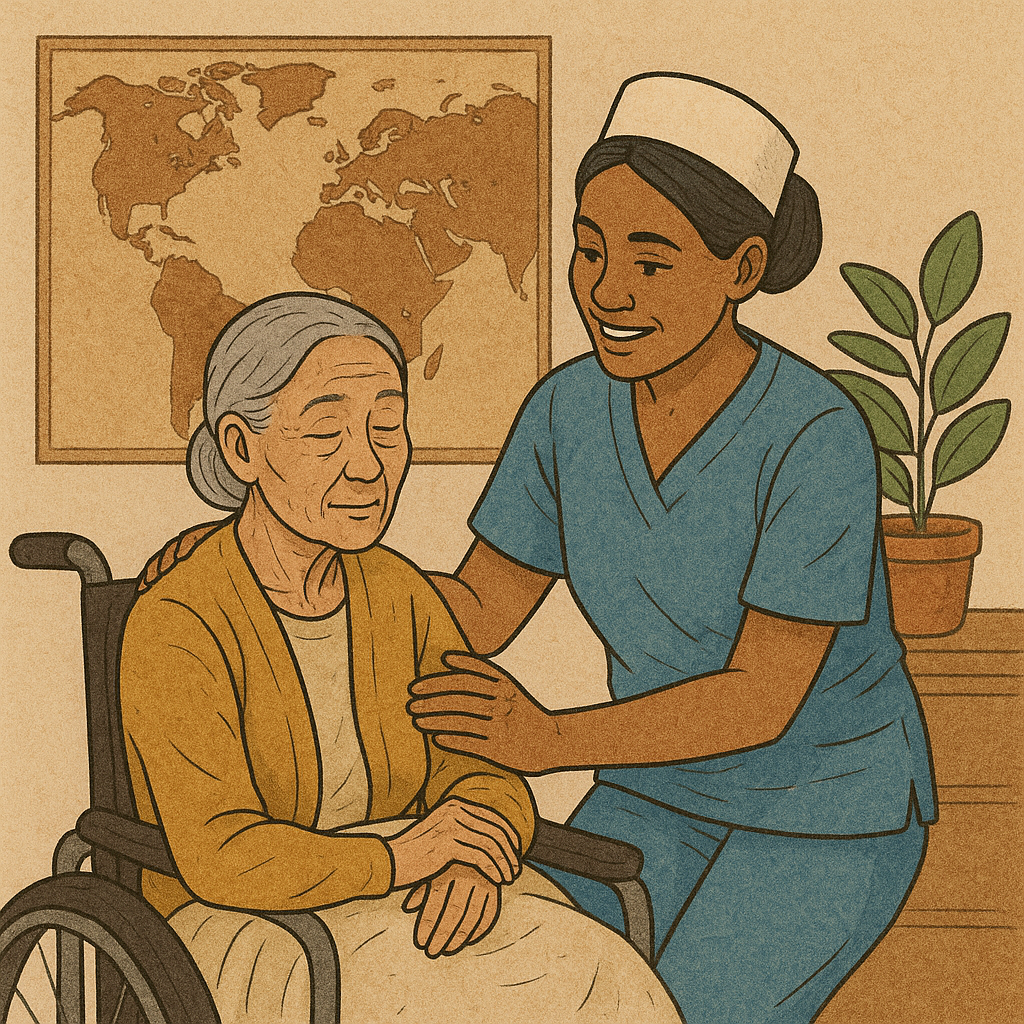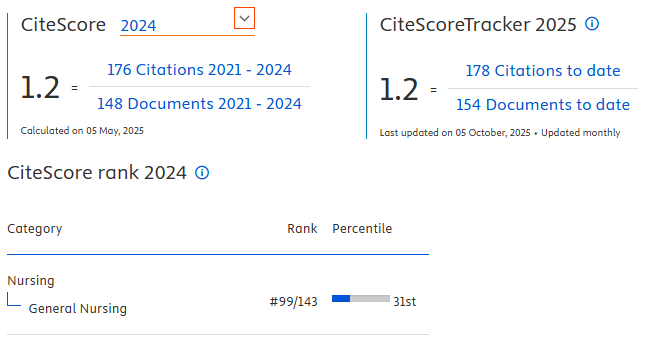Development of a palliative end of life care (PEOLC) model based on transcultural nursing for patients in need of long-term care

Downloads
Introduction: Palliative end-of-life care (PEOLC) is heavily impacted by culture and always discusses death, bereavement, uncertainty, loss, grief, and incurable disease. Long-term care and more culturally sensitive nursing care are essential to address the diverse needs of patients. This study aimed to develop a PEOLC model grounded in transcultural nursing principles, with a focus on enhancing the quality of care for patients requiring long-term support.
Methods: This study employed a cross-sectional explanatory design involving 180 patients with chronic illnesses as participants selected using simple random sampling. The proposed model involved eight variables: patient factors, nurse factors, service factors, family factors, technology factors, the PEOLC model, quality of life, and quality of death. A valid questionnaire was used to collect data, and we employed SEM-PLS to analyse the results.
Results: The PEOLC model had an R2 value of 0.61. These findings showed that 60.1% of the variability of PEOLC variables was explained by the patient, family, nurse, service, and technology aspects. For each construct, a value of Q2 > 0 (0.083) indicated that the model was appropriate. The path coefficient value of 0.343 indicates that the service factors make the most significant contribution to the PEOLC model.
Conclusions: This research led to the development of the PEOLC model, which comprises eight variables. It provides a comprehensive framework for integrating transcultural nursing principles into long-term care and emphasises the importance of cultural sensitivity in delivering personalised and effective end-of-life care.
Agustini, N.L.P.I.B. et al. (2020) ‘Undergraduate nursing students’ knowledge, attitude and practice toward palliative care in Indonesia: A cross-sectional online survey’, International Journal of Psychosocial Rehabilitation, 24(7), pp. 7709–7717. Available at: https://doi.org/10.37200/IJPR/V24I7/PR270741.
Agustini, N.L.P.I.B. et al. (2023) ‘Palliative care learning model based on transformational learning theory in palliative care of nursing students in Indonesia | Modelo de aprendizaje de cuidados paliativos basado en la teoría de aprendizaje transformacional de cuidados paliativos de los e’, Enfermeria Clinica, 33(2), pp. 102–114.
Agustini, Ni Luh Putu Inca Buntari et al. (2023) ‘Philosophy of Science on The Development of Palliative Nursing Practice in The Implementation of Long-Term Care for The Elderly: A Literature Review’, Jurnal Info Kesehatan, 21(2), pp. 226–238. Available at: https://doi.org/10.31965/infokes.vol21.iss2.1064.
An, E. et al. (2022) ‘Protocol for the development and multisite validation of the Quality of Dying and Death-Revised Global Version scale’, BMJ Open, 12(7), pp. 1–8. Available at: https://doi.org/10.1136/bmjopen-2022-064508.
Barker, R., Wilson, P. and Butler, C. (2021) ‘How does English national end-of-life care policy impact on the experience of older people at the end of life? Findings from a realist evaluation’, Primary Health Care Research and Development, 22(10). Available at: https://doi.org/10.1017/S1463423621000621.
Berhanu, R.D. et al. (2021) ‘Perceived transcultural self-efficacy and its associated factors among nurses in Ethiopia: A cross-sectional study’, PLoS ONE, 16(7 July), pp. 1–13. Available at: https://doi.org/10.1371/journal.pone.0254643.
Connor, S. (2014) Global atlas of palliative care at the end of life.
Eng, V., Hewitt, V. and Kekalih, A. (2022) ‘Preference for initiation of end-of-life care discussion in Indonesia: a quantitative study’, BMC Palliative Care, 21(1), pp. 4–11. Available at: https://doi.org/10.1186/s12904-021-00894-0.
Glyn-Blanco, M.B., Lucchetti, G. and Badanta, B. (2023) ‘How do cultural factors influence the provision of end-of-life care? A narrative review’, Applied Nursing Research, 73(November 2022). Available at: https://doi.org/10.1016/j.apnr.2023.151720.
Grudzen, C.R. et al. (2022) ‘Palliative care models for patients living with advanced cancer: a narrative review for the emergency department clinician’, Emergency Cancer Care, 1(1), pp. 1–10. Available at: https://doi.org/10.1186/s44201-022-00010-9.
Hoare, S. et al. (2024) ‘End-of-life care quality measures: beyond place of death’, BMJ Supportive and Palliative Care, 14(e1), pp. E613–E621. Available at: https://doi.org/10.1136/spcare-2022-003841.
Israfil, I. et al. (2024) ‘Exploring the primary health facility availability, health control, drug consumption, and healthy living behavior among patients with hypertension’, Healthcare in Low-resource Settings, 12. Available at: https://doi.org/10.4081/hls.2024.
Israfil, I., Sinaga, M. and Ludji, I.D.R. (2018) ‘Effect of Patients Behavior and Family Health Companion Role on Hypertension Complication Occurrence’, Unnes Journal of Public Health, 7(2), pp. 133–141. Available at: https://doi.org/10.15294/ujph.v7i2.20982.
Israfil, I., Yusuf, A. and Efendi, F. (2024) ‘Effectiveness of A Health Behavior Module Based on Transcultural Nursing in Efforts to Prevent Cardiovascular Complications on Hypertension Patients in the Community’, Indonesian Journal of Global Health Research, 6(3), pp. 1293–1302.
Lee, H. and Choi, S.H. (2021) ‘Factors associated with quality of dying and death in korean intensive care units: Perceptions of nurses’, Healthcare (Switzerland), 9(1), pp. 1–11. Available at: https://doi.org/10.3390/healthcare9010040.
Linda, S. et al. (2019) ‘PROJECT REPORT ABSTRACT : Keywords : FULL ARTICLE ’:, (July 2018), pp. 2016–2020.
Mayland, C.R. et al. (2022) ‘Measuring quality of dying, death and end-of-life care for children and young people: A scoping review of available tools’, Palliative Medicine, 36(8), pp. 1186–1206. Available at: https://doi.org/10.1177/02692163221105599.
Mosadeghrad, A.M. (2014) ‘Factors influencing healthcare service quality’, International Journal of Health Policy and Management, 3(2), pp. 77–89. Available at: https://doi.org/10.15171/ijhpm.2014.65.
Nuuyoma, V., Muvumwaeni, S. and Chihururu, L. (2024) ‘Transcultural nursing: a qualitative analysis of nursing students’ experiences in a multicultural context in North-Eastern Namibia’, BMC Nursing, 23(1), pp. 1–13. Available at: https://doi.org/10.1186/s12912-024-01773-8.
Paiva, B.S.R. et al. (2023) ‘Translation, Validity and Internal Consistency of the Quality of Dying and Death Questionnaire for Brazilian families of patients that died from cancer: a cross-sectional and methodological study’, Sao Paulo Medical Journal, 141(4), pp. 1–10. Available at: https://doi.org/10.1590/1516-3180.2022.0085.R2.09082022.
Prado, E. et al. (2022) ‘Meanings and Experiences of End-of-Life Patients and Their Family Caregivers in Hospital-to-Home Transitions: A Constructivist Grounded Theory Study’, International Journal of Environmental Research and Public Health, 19(20). Available at: https://doi.org/10.3390/ijerph192012987.
Pruthi, M. et al. (2022) ‘The Palliative Care Knowledge Questionnaire-Basic (PCKQ-B): Development and Validation of a Tool to Measure Knowledge of Health Professionals about Palliative Care in India’, Indian Journal of Palliative Care, 28(2), pp. 180–191. Available at: https://doi.org/10.25259/IJPC_80_2021.
Uddin, M.A. (2019) ‘Development of the family support scale (FSS) for elderly people’, MOJ Gerontology & Geriatrics, 4(1), pp. 17–20. Available at: https://doi.org/10.15406/mojgg.2019.04.00170.
Wenham, S., Cumming, M. and Saurman, E. (2020) ‘Improving palliative and end-of-life care for rural and remote Australians’, Public Health Research and Practice, 30(1). Available at: https://doi.org/10.17061/phrp3012001.
Wilson, F. et al. (2024) ‘Barriers and mechanisms to the development of palliative care in Aceh, Indonesia’, Progress in Palliative Care, 32(1), pp. 22–28. Available at: https://doi.org/10.1080/09699260.2023.2256177.
Zhang, B., Nilsson, M. and Prigerson, H.G. (2023) ‘Factors Important to Patients ’ Quality-of-Life at the End-of-Life’, National Journal of Physiology, Pharmacy and Pharmacology, 172(15), pp. 1133–1142. Available at: https://doi.org/10.1001/archinternmed.2012.2364.Factors.
Copyright (c) 2025 Jurnal Ners

This work is licensed under a Creative Commons Attribution 4.0 International License.
Authors who publish with Jurnal Ners agree to the following terms:
- Authors transfer the Copyright and grant Jurnal Ners the right of first publication with the work simultaneously licensed under a Creative Commons Attribution 4.0 International License that allows others to remix, adapt and build upon the work with an acknowledgment of the work's authorship and of the initial publication in Jurnal Ners.
- Authors are permitted to copy and redistribute the journal's published version of the work (e.g., post it to an institutional repository or publish it in a book), with an acknowledgment of its initial publication in Jurnal Ners.
Jurnal Ners requires a formal written declaration and transfer of copyright from the author(s) for each article published. We, therefore, ask you to complete and return this form, retaining a copy for your own records. Your cooperation is essential and appreciated. Any delay will result in a delay in publication. The form can be downloaded HERE.
































